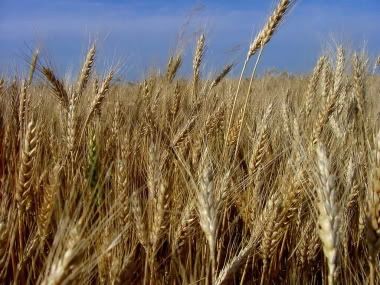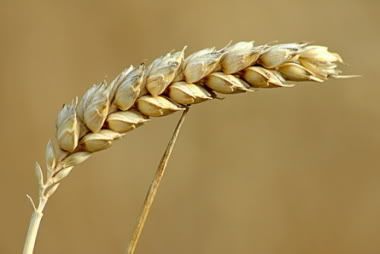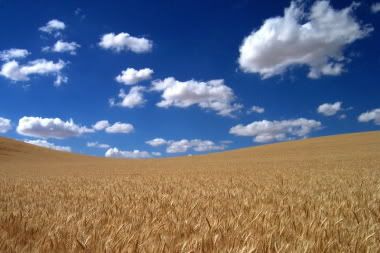
The essential ingredients for communion bread are very simple: water and wheat flour. In fact, unless you were making leavened bread for an Eastern rite liturgy (leavened bread is not a normative part of the Western tradition, which follows the Jewish), wheat flour, water, and heat are the only things you will need.
What many people have not often stopped to consider until now is, Why does it need to be wheat? The commitment to wheat bread (as opposed to rice, corn, or oat bread) is a part of our Judeo-Christian heritage in which Jesus took, used, and gave the Bread of Redemption and the Cup of Blessing from the Seder to us as a sacrifice (a means of divine of worship) and a sacrament (an assured means of grace). The assurance is verified by maintaining the material that Jesus used and the words he spoke over them. In sacramental theology, we call the material the "matter" and we call the words the "form."
In the Anglican tradition, we recognize that the use of pure wheat bread (usually unleavened, since we have a Western liturgical heritage) and pure grape wine (red or white or anything in between as long as it comes from grapes alone) as given by Christ and unchangeable by his Church. In other words, it is not a tradition we created, but a tradition we received. As trustworthy "stewards of God's mysteries" (1 Cor 4:1), the clergy are charged to preserve this tradition intact for the love and care of their people.
As the ecumenical movement was gaining speed, the House of Bishops of the Episcopal Church USA adopted in 1886 a statement of four essentials or non-negotiables for further ecumenical dialog. These were: (1) the Scriptures as the Word of God, (2) the Nicene Creed as a sufficient statement of faith, (3) the dominical sacraments, and (4) the historic episcopate.
Addressing the seriousness with which these essentials of the Christian religion should be taken, the bishops noted that these "principles we believe to be the substantial deposit of Christian Faith and Order committed by Christ and his Apostles to the Church unto the end of the world, and therefore incapable of compromise or surrender by those who have been ordained to be its stewards and trustees for the common and equal benefit of all men."
In listing the dominical sacraments, the Bishops explained: "The two Sacraments,--Baptism and the Supper of the Lord,--ministered with unfailing use of Christ's words of institution and of the elements ordained by Him." The statement was adopted in Resolution 11 of the 1888 Lambeth Conference's statements on ecumenical matters and became known as the Chicago-Lambeth Quadrilateral, printed on pages 877-8 of the American Book of Common Prayer.
According to the Episcopal and Anglican bishops, the sacramental matter (or, "elements ordained by Him") are among those things which are "incapable of compromise or surrender." But, there have always been those for whom that may present difficulties. Alcoholics, for example, have to become accustomed to either feigning a sip from the chalice or simply receiving in one kind alone, as would a sick person or any Roman Catholic up until the 1970s. But what about someone who could not consume wheat--even a small piece or a crumb?
Helen Hitchcock insightfully pointed out: "Some people cannot physically tolerate the gluten in wheat; some are alcoholics who cannot drink wine without risk. How can they receive Communion? First, a communicant who is sensitive to gluten in the Host may receive the Precious Blood; and an alcoholic may receive the Host alone. Furthermore, it is a matter of Church dogma that Christ exists 'whole and entire'--Body, Blood, Soul and Divinity--in each and every particle of each of the consecrated elements, in each crumb and each drop. Therefore: 1) a person who receives a mouthful or a gulp does not receive "more Christ" than one who receives the merest particle or drop; and 2) one receives the 'whole Christ' in either species or form (many, perhaps a majority, of Catholics generally receive the Host alone)."
Looking for possibilities
Still, many were hopeful that some possible way could be found for faithful Christians who suffer from such ailments to be able to receive Holy Communion under both species. Some offered false hopes, that is, by avoiding wheat altogether. One example would be this product offered by Ener-G Foods, a company specializing in the restricted diet market (tip of the biretta to Canon Elizabeth Kaeton).
While it would be a fine substitute for Christian traditions which do not believe that sacramental matter matters in this case, that would be fine. We already see that many Baptists and Methodists use grape juice instead of wine. Mormons use water instead of grape juice or wine. But for Catholic churches like the Episcopal Church and the other provinces of the Anglican Communion, matter does matter. Because matter is what our Lord took from the Virgin Mary for his very own Body. Matter is what Jesus took at the Last Supper to change into that Body. And matter is our only assurance that we have the Real Presence of Jesus Christ in the Eucharist.

The fruits of patience and prayer
Others, not settling for false hopes have persisted in finding true hope for those with celiac disease. A solution has been found thanks to the patience and perseverance of two nuns, Sisters Jane Heschmeyer and Lynn Marie D'Souza, of a Benedictine convent in Clyde, Missouri. Over two years of experiments they have developed a Communion wafer that has been approved as valid matter for the Eucharistic bread by the Holy See. You can read the whole story here. See the sisters and the bread they make here.
The Sisters of the Perpetual Adoration now make and offer an extremely low-gluten wheat altar bread for valid use in the Holy Eucharist. The altar bread can be ordered from the convent. The Hosts are carefully individually hand-made by the sisters for suffers of celiac disease. What is the result? As noted on their website, data from the Center for Celiac Research showed that the 0.01% gluten content of their breads would be perfectly safe for most celiacs. The article states:
The measurement cited here, 0.01%, represents 10 PPMs (parts per million). But the more important number is 37 micrograms, because it is daily exposure to gluten that counts. The best current information shows that 10 milligrams a day should be safe. Ten milligrams is the same as 10,000 micrograms. If you divide 37 micrograms into 10,000 micrograms, you will find that you would have to eat 270 wafers every day to reach the danger point. At most, celiacs would consume one wafer per day or about 0.04% (four tenths of one percent) of the amount considered dangerous.
Soul of Christ, sanctify me.
Body of Christ, save me.
Blood of Christ, inebriate me.
Water from Christ's side, wash me.
Passion of Christ, strengthen me.
O good Jesus, hear me.
Within thy wounds hide me.
Suffer me not to be separated from thee.
From the malicious enemy defend me.
In the hour of my death call me
And bid me come unto thee.
That with thy saints, I may praise thee
For ever and ever. Amen.

Why does matter matter?
During my vacation, I've been reading through some books that I did not finish earlier in the year. One is David Lang's very splendid and enjoyable book called Why Matter Matters. It answers the question that most of us never got around to asking. He addresses all of signs and symbolism of the various the sacramental matter used in the Church's tradition. In the chapter on the use of bread in the Eucharist, Lang first addresses the question, Why bread? Then in this section (which follows, emphasis mine), he addresses the question, "Why wheat?".
Now we address the second and far more puzzling question: why wheat bread? Some actual controversy over the grain used to make Eucharistic bread has erupted in certain dioceses. A very pertinent and practical reason has motivated this dispute: namely, the problem of sprue (or celiac disease). This illness consists in a severe condition of gluten intolerance, in which the ingestion of any grain containing a particular protein (alpha-gliadin) causes an allergic reaction resulting in serious intestinal damage. Many people have been perplexed when the Church's pastors refused to grant any dispensation from the traditional policy prohibiting substitution of a grain other than wheat. (For instance, rice—unlike the grains wheat, barley, oats, and rye—does not contain gluten. Another nonglutinous and hypoallergenic grain is millet.) To them it seemed arbitrary, rigid, and harsh for the Church to recommend that those afflicted with this sickness resort to the alternative of receiving Holy Communion only under the form of sacramental wine. Indeed, this counsel seems "discriminatory" and "judgmental," because in effect it denies the consecrated Host to the sufferers, depriving them of a benefit accessible to nearly everyone else.
Why should it matter, they wondered, which grains are used? Would it make any difference to Jesus what kind of altar bread is converted into the substance of His Body at the Consecration of the Mass? It is a natural human response to raise this question out of compassion in the face of misery. We must be wary, however, of succumbing to a false sense of charity by committing the gnostic error of trivializing material differences.
Just as there is a natural reason why bread should be the only food fit for conversion into the substance of Christ's Body, so also there would seem to be a practical reason why God chose only one particular grain as legitimate for Eucharistic bread. Imagine if any grain were allowed. Inevitably, questions would arise over which cereal foods are really grains, because some that are commonly perceived as grains are actually seed grasses (e.g., wild rice and buckwheat). Ecclesiastical policies would then be intrinsically and inextricably hostage to the accuracy of current botanical determinations. Moreover, developments in hybridization of true grains with other seeds or grasses would further blur distinctions and complicate matters. If the Church capitulated and proclaimed the flour from all these broad cereal groups to be licit ingredients of Eucharistic bread (assuming a well-defined classification could be relied upon), some people would predictably test the boundaries of the liberalized Canon Law and protest the exclusion of other starchy foods (for instance, potatoes or beans). An interminable debate would beset sacramental theology and its pastoral applications — far worse than now. In His infinite wisdom and compassion God has authoritatively settled the matter once and for all by selecting pure wheat as the sole grain for altar bread. (Exceptions for hard cases, such as allergies, would make a mess of things here and would wind up destroying the general principle.)
The Church's official doctrine permitting only wheat flour as valid matter for composing Eucharistic bread cannot, of course, be strictly proved by unaided human reasoning. It can, however, be somewhat logically defended on the basis of agricultural observation and even more persuasively justified on the basis of Scripture. Let us again recall that the sacraments employ material things as channels of grace, actually bringing about in reality what they signify. Furthermore, it is a plain fact that some materials are more suited than others for playing a specific symbolic role. We saw, for example, the intimate connection between water and Baptism in Chapter 1.
Why, among all grains, is wheat the most appropriate for the Holy Eucharist, in which Christ's Body is truly present under the appearances of bread? Wheat alone bears to a superlative degree both the agricultural and Biblical connotations of being sown, fallen, crushed, buried, and then risen after harvest into life-giving bread to be broken and shared. These are all symbols of Christ's passion, death, resurrection, and Real Presence to us in the Holy Sacrifice of the Mass. No grain other than wheat carries all these meanings to such a high peak of intensity.
Moreover, Christ instituted the sacraments containing matter in commonplace use among mankind, as ordinary (albeit highly significant) water in Baptism exemplifies. St. Thomas Aquinas asserts: "Now among other breads wheaten bread is more commonly used by men"; in fact, other grains' breads are usually eaten only when wheat bread is unavailable. And according to one authority on the subject, wheat "covers more of the earth's surface than any other grain crop." Therefore, it seems that wheat, more than any other grain, aptly symbolizes the universality of Christ's call to partake of His Body under the form of bread (as we read in John 6:32-35, 41, 48-59).
Another relevant facet open to ordinary human observation is the shimmering beauty of a field of standing wheat shining like gold in bright sunlight. But the gleam of untarnished gold signifies the pure glory of the divine majesty— an effulgence that radiates toward God's royal subjects, transforming them and their surroundings (much as the worthy reception of the Blessed Sacrament in Holy Communion transforms). For instance, in Job 22:25-26, RSV, we read: "If the Almighty is your gold, . . . / then you will delight yourself in the Almighty, / and lift up your face to God." It is remarkable that the first and last specific elementary mineral substance mentioned in Sacred Scripture is gold (see Genesis 2:11 and Revelation 21:21, prescinding from the subsequent more generic descriptors "glass" and "crystal"); thus, gold is "the Alpha and the Omega" of minerals representing God Himself (Revelation 22:13). It is also important to note that the sacred vessels in which consecrated Hosts are kept (reposed in the ciborium and solemnly exposed in the monstrance) are made of gold, a precious metal that has come to be associated with the Blessed Sacrament. This fact is prefigured by Solomon's lavish adornment with gold overlaying the temple's inner sanctuary, where the ark of the covenant rested, in 1 Kings 6:19-22. Hence, wheat and the Holy Eucharist are symbolically related via the medium of gold — a fascinating point that we shall have occasion to recall more than once in the sequel. (A linguistic curiosity: the English words "wheat" and "white," corresponding to the German weizen and weiss, respectively, are derived from Middle and Old Anglo-Saxon roots meaning "to gleam.")



3 comments:
Actually those with the most severe cases of celiac disease can't receive either of the elements, especially where intinction is permitted. There aren't very many cases that bad, but sometimes even 10 ppm is to much for the body to handle.
Jon
True, which is why one should let the pastor know, so an uncontaminated cup can be provided on a regular basis.
The uncontaminated cup may need to have a special wine in it as well. Depending on how it has been processed it may have gluten in it as well.
Jon
Post a Comment